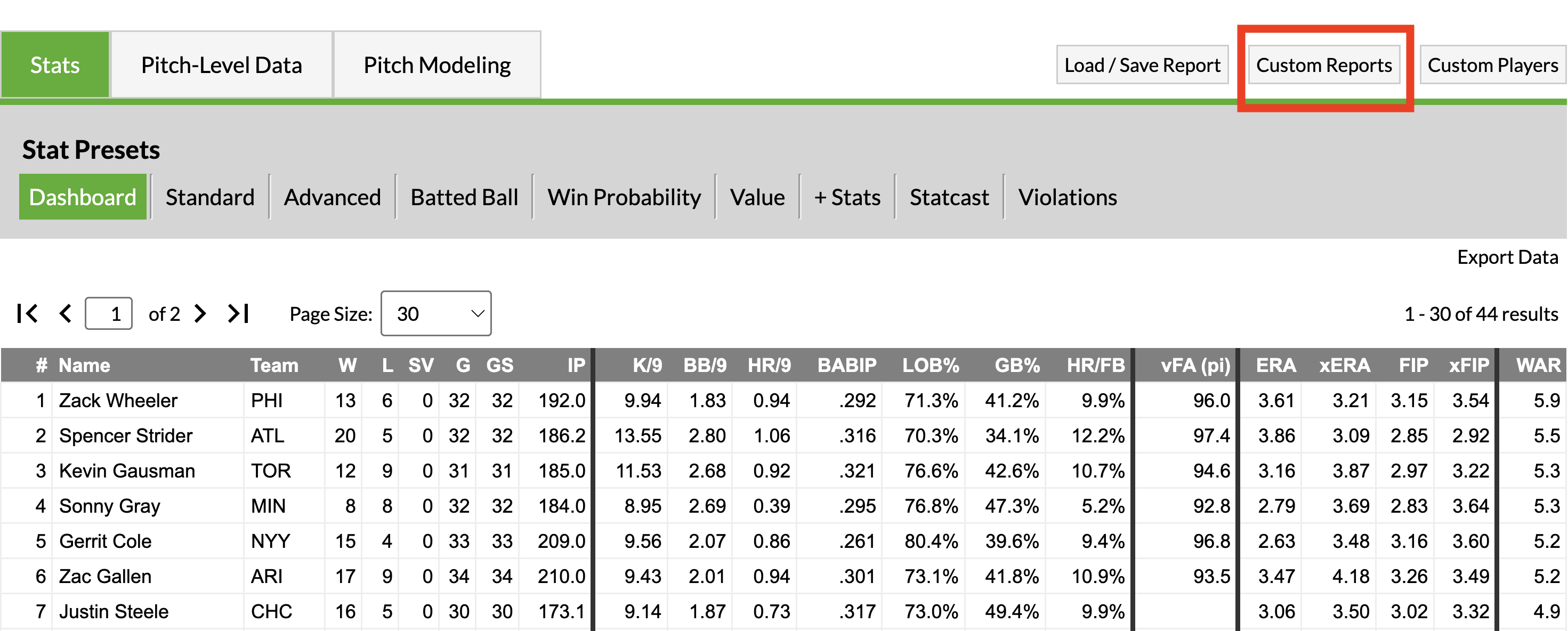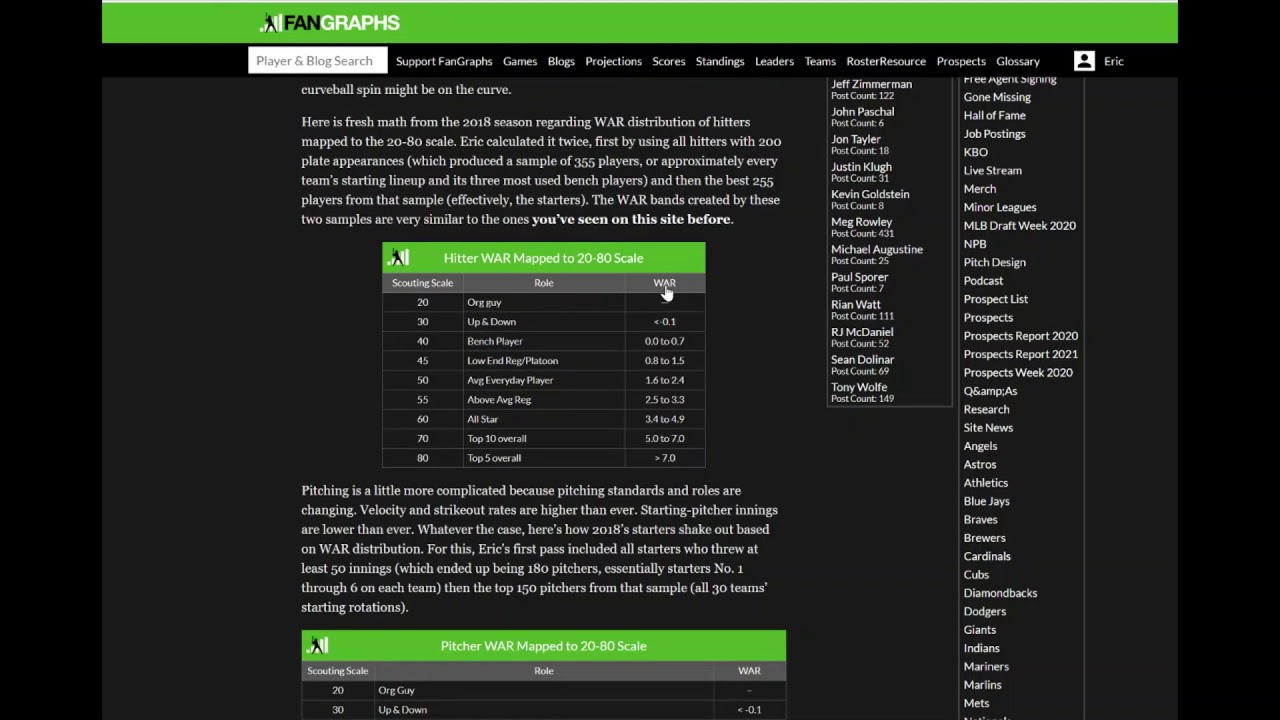How to use fangraphs data sports betting

There are three main ways to view The Board. There is a “Scouting Only” section, a “Stats Only” section, and a chocolate/vanilla swirl version. Members have the ability to then hit the handy-dandy Export button and how to use fangraphs data sports betting a spreadsheet, but even non-Members can use the custom reports and. This is my strategy: Use fangraphs win probabilities for each game and compare that probability with the money line to determine if the bet is. Let's take FanGraphs' standard dashboard data for qualifying MLB batters in and Save it as something short, like “westcoasteaglesfans.com.au”. (If you.
Unlocking the Power of FanGraphs Data for Sports Betting
When it comes to gaining an edge in the world of sports betting, one of the most valuable tools at your disposal is leveraging advanced statistical analysis and data. In recent years, platforms like FanGraphs have revolutionized the way we approach sports analytics, offering a treasure trove of information that can be incredibly useful for making informed betting decisions.
By utilizing FanGraphs data, you can delve deep into player performance metrics, team statistics, and other key insights that go beyond the surface-level statistics often available to casual fans. However, to truly make the most of this wealth of data, it's essential to know how to interpret and apply it effectively.
Player Performance Analysis
One of the essential aspects of using FanGraphs for sports betting is conducting in-depth player performance analysis. By examining metrics such as wOBA (Weighted On-Base Average), xwOBA (Expected Weighted On-Base Average), and WAR (Wins Above Replacement), you can gain a comprehensive understanding of a player's impact on the field beyond traditional stats like batting average or ERA.
Comparing players based on these advanced metrics can help you identify undervalued or overvalued assets, giving you a competitive advantage when placing bets on player performance-related markets.
Team Statistics and Trends
Beyond individual player analysis, FanGraphs data can also provide valuable insights into team performance trends and statistics. Whether you're looking at offensive production metrics like wRC (Weighted Runs Created Plus) or pitching statistics such as FIP (Fielding Independent Pitching), understanding how teams perform based on these advanced metrics can help you make more accurate predictions when betting on team outcomes.
Identifying teams that may be underperforming or exceeding expectations according to these advanced metrics can help you spot betting opportunities that others might overlook.
Conclusion
When used correctly, FanGraphs data can be a powerful tool to enhance your sports betting strategy. By immersing yourself in the wealth of advanced statistics and insights available on the platform, you can make more informed decisions and increase your chances of success in the competitive world of sports betting. Remember to approach the data with a critical eye, combine it with other relevant information, and stay up to date with the latest trends to stay ahead of the game.
FanGraphs Baseball
How do you convert probability to odds? How to convert odds to probability and odds to a probability
- To convert from a probability to odds, divide the probability by one minus that probability. So if the probability is 10% or 0.10 , then the odds are 0.1/0.9 or '1 to 9' or 0.111.
- To convert from odds to a probability, divide the odds by one plus the odds.
How do you use statistics in betting? Usting statistics for betting
What is the difference between game power and raw power in fangraphs? “Game” power is a grade describing power output. While raw power is “How far/hard can they hit the ball?”, game power is “What is their power production like in actual games?” These two are often different for any number of reasons (often augmented by swing plane, approach, or hit tool quality).
How does FanGraphs calculate war for pitchers? FanGraphs' main WAR for pitchers is based on FIP with infield flies counted as strikeouts. We also have a version of WAR called RA9-WAR that uses RA9 instead of FIP. We use a special FIP-based park effect when computing WAR which you can find here.
The effectiveness of using statistics really depends on what type of bet you are placing. Markets like the number of goals, the number of corners, the number of cards are examples of markets where many bettors will base their bets on statistics.What does def mean on FanGraphs? Def measures the numbers of runs above or below average a player is worth when combining their fielding runs and positional runs. Zero is league average and every ten runs (approximately) in each direction is a win above or below average.
How do you convert odds to moneyline? If the moneyline is positive, it is divided by 100 and add 1. Thus, +400 moneyline is the same as 5.0 in decimal odds. If the moneyline is negative, 100 is divided by the absolute moneyline amount (the minus signed is removed), and then 1 is added. For example, −400 moneyline is 100/400 + 1, or 1.25, in decimal odds.
Intro to Data Science Part 4: Testing Your Hypothesis
So we can see that the average player in this data set had roughly a. Want to compare how the and stats stack up. R makes it pretty easy to pick out subsets of data. You can do whatever basic statistical tests you like— sd for the standard deviation, et cetera—and pull out different subsets of the data based on whatever criteria you like.
And, of course, you can access the documentation through a function. Use help help head , help summary , etc. One final note: typing code directly into the console is fine, but it gets a bit annoying if you want to write more than a line or two. Instead, you can create a new window within R to load, edit and run scripts. Feel free to download and start tinkering. So those are the basics of R; not enough to really show its potential, but enough to start experimenting and exploring as you wish.
Stay tuned. Brice lives in the Washington, DC area, where he does communications for linguistics and space exploration organizations. He's on Twitter at KilroyWasHere. So there was another Techgraphs article not too long ago asking what the readers would like to see more of. Thanks for the kind words!
R is my favourite. Toss in the Lehman DB and you can have a blast. Just about every test you can imagine is either installed by default, available as a package, or scripted somewhere online. How to use fangraphs data sports betting If you have statistical knowledge and basic computer knowledge, you can probably knock out the learning curve for MYSQL and R in a weekend. I have not only learned things for Baseball data manipulation but also have learned some things that I can use in my actual work.
Great article. Been looking for a good introduction to R and MySQL and using baseball is a great way to use it for learning by keeping me interested with a topic I actually care about. I look forward to the continuation of these articles. Being able to see all your code, re-run bits of it without typing again, having your code and your results in two different panes — it really lowers the barrier of frustration for new users.
What is the code for that. I tried working it out but failed. Not by typing that, apparently. Or where do I find the folder R has listed as the working directory. You may need to click on the console window first, if you have a script or something else open.
Thanks, Brice. I can download the data by highlighting it and dragging it into Excel, but then the data are in multiple sheets, and only one sheet at a time can be saved as a.  Or if you can show me a way to do that…. That should let you download the data as a CSV. There is supposed to be a tab used for downloading data into Excel in either the or versions different names for the tabs, one of them is new web entry, I forget what the other is , but neither tab is in my version.
Or if you can show me a way to do that…. That should let you download the data as a CSV. There is supposed to be a tab used for downloading data into Excel in either the or versions different names for the tabs, one of them is new web entry, I forget what the other is , but neither tab is in my version.
Leaderboards, player stats, playoff odds, projections, and much more. Recent Articles. So Far, Michael Busch Has Been a Big Hit for the Cubs Traded when his path to playing time with the Dodgers was blocked by superstars, the year-old rookie has been one of the majors' top sluggers so far. Anthony Volpe's Changes Couldn't Be Going Any Better After remaking his swing over the offseason, the Yankees shortstop is enjoying the best stretch of his young career.
Please consider becoming a FanGraphs Member. All the great work that you've come to rely on is made possible by Member support, including analysis, stats, projections, RosterResource, prospect coverage and podcasts. Can He Stay Berserk. Player's View: Tales From the Minor Leagues Nine people from around baseball share anecdotes from their time down on the farm.
With a weak division and some key injuries to the Twins and Guardians, the Royals making it back to the playoffs is at least plausible. Spencer Strider Undergoes Surgery, Will Miss Remainder of Season Strider didn't have standard Tommy John surgery, instead opting for an internal brace that could reduce his rehab time. What does that mean for him, his team, and baseball more broadly?
More FanGraphs Articles. Subscribe to the FanGraphs Newsletter Email:. RotoGraphs RosterResource Roundup: April A roundup of recent notable roster moves and notes, as well as future expected moves. Starting Pitcher Chart — April 17th, Solid full slate on Wednesday presenting a lot of opportunities regardless of league size.
Roto Riteup: April 16, News, notes and streaming pitchers to stat your day off Rite. More Fantasy Articles. Community How to Submit. Comparing the Japanese slugger to other recent players to arrive from NPB. A fine look at which parts of the four-seam fastball are most important to success. More Community Articles. More Job Postings.
Prospects Top Prospects The FanGraphs prospect team presents their top list, with reports for each player. More Essential Articles. They also contain all the data you could want about individual pitch shapes and effectiveness. Site News FanGraphs Spotlight: Positional Splits A handy tool for highlighting which teams are getting the most and least at each spot — and who's contributing to it.
More Site News. Top Prospects All orgs will receive a full list. Podcasts 4h — Episode Whoops it Up.
Popular Pages
- Is mobile sports betting legal in nevada
- How much do sports betting apps make
- Is tennis the best sport to bet on
- How do sports betting sites make money
- How to place a sport pesa bet online
- What does a walkover in tennis mean sports bet
- Why was sports betting illegal
- Does sands casino have sports betting
- How to track sports bets on excel
- How much money to start sports betting